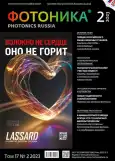Processing of optical crystals and leds in glow discharge plasma
- Authors: Bogachev M.A.1,2, Vasiliev D.D.1,2, Moiseev K.M.1,2, Nazarenko M.V.1,3
-
Affiliations:
- GNtech LLC
- Bauman Moscow State Technical University
- Russian Technological University MIREA (RTU-MIREA)
- Issue: Vol 17, No 2 (2023)
- Pages: 108-113
- Section: Technologies & Technology Equipment
- URL: https://journals.eco-vector.com/1993-7296/article/view/627296
- DOI: https://doi.org/10.22184/1993-7296.FRos.2023.17.2.108.112
- ID: 627296
Cite item
Abstract
Glow discharge plasma treatment is increasingly being used to clean the surfaces of materials from contamination, reduce surface roughness, increase surface energy and surface modification. The article presents the results of plasma processing of high-frequency and low-frequency gas discharge in the MPC RF-12 plasma processing unit of optical crystal disks and cassettes of solid-state LEDs. The influence of parameters and modes of plasma treatment, namely power, time and type of working gas on the quality of treatment is estimated. It is shown that plasma treatment is a powerful tool for influencing the surface properties of optical crystals, is effective for removing metal oxide layers and is safe for adhesive joints of crystals with a base.
Full Text
About the authors
Maksim A. Bogachev
GNtech LLC; Bauman Moscow State Technical University
Email: journal@electronics.ru
ORCID iD: 0000-0001-6580-0103
1st year master’s student of the Department of Electronic Technologies in Mechanical Engineering; Engineer
Russian Federation, Moscow; MoscowDenis D. Vasiliev
GNtech LLC; Bauman Moscow State Technical University
Email: journal@electronics.ru
ORCID iD: 0000-0003-2147-4216
Cand. of Scien. (Engineering), Associate Professor of the Department of Electronic Technologies in Mechanical Engineering; Lead Engineer
Russian Federation, Moscow; MoscowKonstantin M. Moiseev
GNtech LLC; Bauman Moscow State Technical University
Email: journal@electronics.ru
Cand. of Scien. (Engineering), Associate Professor of the Department of Electronic Technologies in Mechanical Engineering; technical director
Russian Federation, Moscow; MoscowMaria V. Nazarenko
GNtech LLC; Russian Technological University MIREA (RTU-MIREA)
Author for correspondence.
Email: journal@electronics.ru
ORCID iD: 0000-0002-8753-7737
PhD student, Department of Nanoelectronics; Process Engineer
Russian Federation, Moscow; MoscowReferences
- Kovsh I. B. Photonics in Russia: State & Challenges. Part I. Photonics Russia. 2019;13(2):130–141. doi: 10.22184/1993-7296.FRos.2019.13.2.130.141.
- Segev M., Bandres M. A. Topological photonics: Where do we go from here? Nanophotonics. 2021;10(1):425–434. doi: 10.1515/nanoph-2020-0441.
- Wu Y., Li C., Hu X., Ao Y., Zhao Y., Gong Q. Applications of topological photonics in integrated photonic devices. Advanced Optical Materials. 2017;5(18): 1700357. doi: 10.1002/adom.201700357.
- Pelucchi E., Fagas G., Aharonovich I., Englund, D, Figueroa E., Gong Q. et al. The potential and global outlook of integrated photonics for quantum technologies. Nature Reviews Physics. 2022;4(3):194–208. doi: 10.1038/s42254-021-00398-z.
- Singh M., Weidner K. Types and performance of high performing multi-mode polymer waveguides for optical interconnects/ In book: Optical Interconnects for Data Centers. Woodhead Publishing Series in Electronic and Optical Materials. 2017;157–170. doi: 10.1016/B978-0-08-100512-5.00006-1.
- Kachura S. M., Postnov V. I. Perspektivnye optovolokonnye datchiki i ih primenenie (obzor). Trudy VIAM. 2019; 5 (77). (In Russ.). Качура С. М., Постнов В. И. Перспективные оптоволоконные датчики и их применение (обзор). Труды ВИАМ. 2019; 5 (77).
- Miftahov I. S., Voznesenskij E. F., Abdullin I. Sh., Fadeev A. O., Gataullin L. Primenenie plazmy VCh-razryada ponizhennogo davleniya v processah polirovki opticheskih materialov polikristallicheskogo stroeniya. Vestnik Kazanskogo tekhnologicheskogo universiteta. 2015; 11. (In Russ.). Мифтахов И. С., Вознесенский Э. Ф., Абдуллин И. Ш., Фадеев А. О., Гатауллин Л. Применение плазмы ВЧ-разряда пониженного давления в процессах полировки оптических материалов поликристаллического строения. Вестник Казанского технологического университета. 2015;11.
- Gribenyukov A. I., Voevodin V. I. Influence of the preparation conditions on optical properties of single crystals ZnGeP2 in THz range // J. Phys. Conf. Ser. – 2018. – № 1115. – P. 052030.
- Gerhard C., Stappenbeck M. Impact of the Polishing Suspension Concentration on Laser Damage of Classically Manufactured and Plasma Post-Processed Zinc Crown Glass Surfaces. Appl. Sci. 2018, 8, 1556. https://doi.org/10.3390/app8091556.
- Vasiliev A. Osobennosti tekhnologii proizvodstva svetodiodnyh svetil’nikov. Sovremennaya svetotekhnika. 2010;5. (In Russ). Васильев А. Особенности технологии производства светодиодных светильников. Современная светотехника. 2010;5.
- Belyaev V. Tverdotel’nye i organicheskie mikrosvetodiody – tekhnologiya, rynok, perspektivy. Elektronika: Nauka, tekhnologiya, biznes. 2018; 8. doi: 10.22184/1992-4178.2018.179.8.102.112. (In Russ). Беляев В. Твердотельные и органические микросветодиоды – технология, рынок, перспективы.Электроника: Наука, технология, бизнес. 2018; 8. doi: 10.22184/1992-4178.2018.179.8.102.112.
- Moiseev K. M., Vasiliev D. D., Mikhailova I. V., Vorobev I. A. Development of Plasma Processing Systems for Optics and Electronics Products. Photonics Russia. 2022;16(2):136–141. doi: 10.22184/1993-7296.FRos.2022.16.2.136.140.











